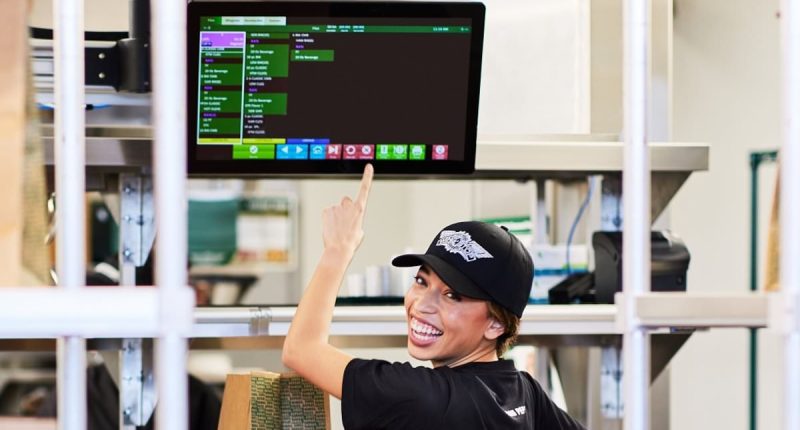Share this @internewscast.com
Wingstop’s ‘game changing’ Smart Kitchen is taking the restaurant chain to new heights.
The new AI-powered kitchen has helped hundreds of locations slash their standard wait times in half – from around 20 minutes to around 10.
The technology has greatly surpassed traditional paper-ticket methods, with only a 16-minute average wait time during the Super Bowl, one of Wingstop’s busiest times of the year.
The company is aiming for shorter wait times to entice Americans to choose it for lunch and to make it a quick option on delivery apps.
“Delivering on the customer’s expectation of a 10-minute wait at lunchtime and doing it reliably, we believe is a significant advantage,” Wingstop CEO Michael Skipworth told Restaurant Business.
The Smart Kitchen testing phase began over a year ago after it was placed in about 30 restaurants.
Now, it’s in more than 400 Wingstop restaurants, and the chain plans to expand systemwide by the end of the year.
The buffalo-style chicken wing chain was established in Garland, Texas, in 1994, and now has over 2,000 restaurants worldwide.

Wingstop tested the Smart Kitchen in 30 restaurants for over a year before expanding it to other locations

The buffalo-style chicken wing chain was established in Garland, Texas, in 1994, and now has over 2,000 restaurants worldwide
In the past, the chain would have a standard wait time of around 30 to 40 minutes on third-party delivery apps, said Skipworth.
That meant that Wingstop would not even show up in platform searches that allow customers to filter for delivery under half an hour.
‘But with Smart Kitchens, Wingstop is now showing up as “fastest near you,” or showing up in the “under 30 minutes” category,’ he told Restaurant Business.
Each machine uses collected data to predict how long a product will take to make.
Data factors include time, weather patterns and sports events.
When the orders come in, they appear on a screen at the ‘bombardier station’ and show graphics indicating the amount and type of chicken to cook.
Employees can then swipe the images when an order is completed, which will automatically show up on another screen at the ‘wingman station,’ the machine where chicken is sauced and tossed.
Workers can then take orders to the ‘pilot station,’ package them according to directions from the ‘wingman station,’ and add a sticker with order details to the bag after the machine prints it out.

Wingstop’s Smart Kitchens are slashing standard wait times by 50 percent in over 400 restaurants

Each machine uses collected data to predict how long a product will take to make

CEO Michael Skipworth believes Smart Kitchens will ultimately help draw in more guests
During the early stages, Skipworth told analysts the system would help ensure its service speed met customer expectations.
Employees have been getting antsy while waiting for their days of squinting at paper tickets to be over.
‘I’m getting phone calls every day from partners (franchisees) asking to be moved to the top of the rollout list,’ said Marisa Carona, senior vice president, chief US franchise operations and development officer.
Employees can learn how to use Smart Kitchens in one shift, and installation costs are expected to be offset by sale increases.
While Smart Kitchens have worked wonders for Wingstop, other chains are also turning to AI in the hope of better efficiency and customer satisfaction, but also potential job losses for fast food workers.
Yum Brands, the owner of Taco Bell, KFC, and Pizza Hut, is planning to use AI for all drive-thru orders by this summer.
McDonald’s is also planning to add AI technology to all locations worldwide over the next few years.
Other fast food restaurants that are experimenting with AI include Wendy’s, Chipotle, and Chick-fil-A.
DailyMail.com has reached out to Wingstop for comment about its Smart Kitchens.
















